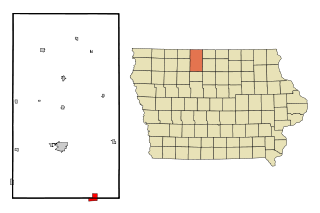
Kossuth County is a county in the U.S. state of Iowa. As of the 2020 census, the population was 14,828. The county seat is Algona.

Hancock County is a county in the U.S. state of Iowa. As of the 2020 census, the population was 10,795. The county seat is Garner. The county was founded on January 15, 1851, and named in honor of John Hancock, a leader of the Continental Congress during the American Revolution.

Lu Verne is a city in Humboldt and Kossuth counties in the U.S. state of Iowa. The population was 258 at the time of the 2020 census.
The Northwest Conference was a high school athletic conference in Iowa. Over the years membership ranged anywhere from five to nine schools. The conference was known over the years as one of the best 1A basketball conferences in Iowa. Traditional powers Newell-Fonda and Pomeroy-Palmer combined for 14 state appearances and six state titles between 1990 and 2004. The conference also sponsored volleyball, women's basketball, men's and women's golf, men's and women's track, baseball, softball, and cross country.
The Siouxland Conference is a ten team high school athletic conference in the northwest corner of Iowa, consisting of schools ranging from the smallest class (1A) to the third largest class (3A), and known for its prominence in small school basketball.
The War Eagle Conference is a 11-team high school athletic conference in Northwest Iowa. The schools are classified as 1A and 2A, the two smallest classes in Iowa. The conference is widely recognized as one of the best small school baseball conferences in the state, often sending multiple teams to the state tournament. The WEC has also been successful in boys basketball housing multiple state champions, the most recent being South O’Brien boys in 2015–16 as Class 1A state champions at a record of 25–3. Remsen St. Mary’s has been the most recent qualifiers the past two seasons
The Twin Lakes Conference is an athletic conference in Iowa, made up of 2A and 1A schools, the two smallest classes of schools in Iowa.

The North Central Conference (NCC) is an athletic conference comprising eight high schools located in North Central Iowa. The member schools are classified as 3A (the second largest classification in Iowa), 2A, and 1A (the smallest classification). The conference was established in 1925.
Algona High School is a rural public high school located in the Algona Community School District in Algona, Iowa, United States. The Algona district includes Algona, Burt, Corwith, Lu Verne, Titonka, Wesley, and Whittemore.

North Kossuth Community School District is a rural public school district based in Swea City, Iowa. Located in northern Kossuth County, it serves Swea City, Bancroft and Ledyard.
Sentral Community School District was a school district headquartered in Fenton, Iowa. It served the communities of Fenton, Lone Rock and Seneca. The spelling "Sentral" was deliberately adopted to be a reference to "Seneca" and to differentiate itself from various other school systems using the word "Central". As of 2004 the district had around 300 students. Their mascot was known as the "Spartans" and before that the "Satellites".

Ruthven-Ayrshire Community School District is a rural public school district headquartered in Ruthven, Iowa. Also serving Ayrshire, the district is located in Palo Alto and Clay counties.
Algona Community School District is a rural public school district headquartered in Algona, Iowa.
Titonka Consolidated School District was a school district headquartered in Titonka, Iowa, United States.
Corwith–Wesley Community School District was a school district based in Corwith, Iowa, serving Corwith and Wesley. The district occupied sections of Hancock and Kossuth counties as well as a small portion of Wright County.
Lu Verne Community School District was a rural public school district headquartered in Lu Verne, Iowa.

Graettinger–Terril Community School District (G-T) is a rural public school district in Iowa, with campuses in Graettinger and Terril. The district lies within four counties: Clay, Dickinson, Emmet, and Palo Alto.
Lakota Consolidated School District was a school district serving Lakota, Iowa.






